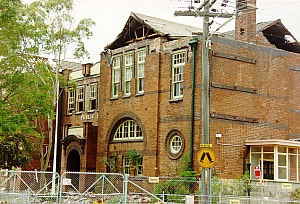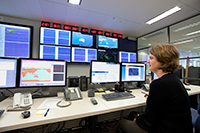News
Australian earthquakes explained
Published:3 July 2015
Australian earthquakes explained
Dan Jaksa and Hugh Glanville

Railway track damage caused by the
1968 Meckering Earthquake.
Reproduced with permission from Alice Snooke
When it comes to earthquakes, living in Australia is much safer than other parts of the world, as Australia is well away from tectonic plate boundaries where large earthquakes occur more frequently. However, the Australian continent can still experience potentially damaging earthquakes, such as the magnitude 6.7 Meckering earthquake in October 1968 or the magnitude 5.7 Newcastle earthquake in December 1989.
Australia's earthquakes are caused by the sudden release of stress that slowly builds up across the Australian tectonic plate as it moves northeast about 7cm per year. The Australian plate is the fastest moving continental land mass on Earth and is colliding into the fastest moving tectonic plate, the Pacific plate which is to Australia's north and east. These combined tectonic movements cause the build-up of stress in the interior of the Australian plate, which is then released during earthquakes.
How do we measure the size of an earthquake?
Earthquakes result from the vibrations that occur when rocks within the earth break or move due to stress. The underground surface along which movement occurs is called the fault plane. The waves of energy that are emitted along this fault plane, the seismic waves, are what we physically measure. We use instruments called seismometers to measure the amplitude of these waves, which describe the amount of energy released during the earthquake.

Newcastle earthquake damage, December 1989
If we know the distance the seismic waves have travelled we can calculate the magnitude or size of the earthquake. Because seismic energy lessens as it moves away from the source we must account for this distance before we can correctly calculate the magnitude.
The magnitude scale is logarithmic, so for every unit increase in magnitude there is a 10-fold increase in the amplitude of the waves in the seismogram. There is also a 32-fold increase in the energy released.
For instance, a magnitude 6.0 earthquake releases approximately 32 times more energy than a magnitude 5.0. A magnitude 5 equates to the energy release of an underground nuclear blast. So, for example, the magnitude 9.0 Sumatran earthquake in 2004 that caused the Indian Ocean-wide tsunami was approximately equivalent to the energy released by 3.5 million standard atomic blasts.
Why are earthquakes felt in different ways?
Magnitude is only one indicator of the expected impacts that an earthquake can have in any given region. The resulting severity of shaking during an earthquake is affected by other specific and unique factors such as the depth of the earthquake, local geology and soil conditions. Building damage also depends on the quality and type of construction. Clearly, the distance from the epicentre will also have an effect on the vibrations felt at a location.
The 2-dimensional location of an earthquake is known as its epicentre. This is the point plotted on a map. Sometimes the earthquake's location is also called the hypocentre. The hypocentre is the 3-dimensional location of the earthquake, which, along with its location, includes its depth within the Earth. Because a seismogram clearly depicts the onset of an earthquake, the location measured defines the point where the earthquake begins to rupture along the fault plane. For large earthquakes, the epicentre is not necessarily the point along the fault plane where the most shaking or damage will occur.
Earthquake and tsunami monitoring
Geoscience Australia monitors, analyses and reports on significant earthquakes to alert emergency managers, government and the public about earthquakes in Australia and overseas. These alerts then enable emergency managers to inform the community of earthquakes in their local region, and for the appropriate level of emergency response and assistance to be dispatched.
Geoscience Australia provides a 24/7 earthquake monitoring and alerting service. As earthquakes cannot be predicted, an earthquake can only be alerted for its time, location and magnitude once it has been recorded and analysed by the Geoscience Australia Duty Seismologist. Firstly, the seismic energy must be large enough to reach a minimum of three seismometers. This can take about 3 to 4 minutes.
Once the location of the earthquake has been computed, the magnitude can be determined. This can take a further 3 to 4 minutes. So earthquake are generally notified in about 10 minutes, but are always alerted as soon as possible. Sometimes the alerts can be as quick as 6 to 7 minutes depending on the distribution and number of seismometers around the epicentre. However, small earthquakes with magnitude less than 2.5 can take longer as the seismic waves can sometimes be difficult to analyse.
Geoscience Australia also operates the Joint Australian Tsunami Warning Centre (JATWC) in collaboration with the Australian Bureau of Meteorology. The JATWC is the official provider of tsunami warnings for Australia. It is also one of three Tsunami Warning Service providers for the Indian Ocean Tsunami Warning and Mitigation System, along with Indonesia and India. The JATWC monitors, analyses and alerts for earthquakes that have the potential to generate tsunami waves that can impact Australia and Indian Ocean countries. It operates 24/7 and can issue tsunami bulletins within 15 minutes of the start of the rupture of a potentially tsunamigenic earthquake.
Letting the community know when an earthquake occurs
Earthquake alerts are important for emergency managers and the general public. For small earthquakes that occur nearby, the tremor may sound like an explosion or a strong thud, like something has smashed into the house. The effected population want to know what it was and what¿s likely to happen. If Geoscience Australia can locate a seismic event, then we can determine its magnitude and advise the public via the Geoscience Australia website and @EarthquakesGA Twitter feed.

Geoscience Australia Duty Seismologist
monitors earthquakes in the Earthquake
Alert Centre which also forms part of the JATWC
For large, potentially damaging earthquakes which may shake an entire State, the need for an immediate emergency response to save lives becomes vital. Although a large area or region may have been impacted by the earthquake's shaking, the earthquake alert provides emergency responders the location of the most likely areas of greatest damage and where to initially focus their rescue efforts.
There are a number of ways to remember what to do if an earthquake occurs. People who experience an earthquake should stay indoors and seek shelter under a table, bench or door frame - you can remember to "Drop, Cover, Hold" when you feel an earthquake. Afterwards it is vital to stay vigilant - expect possible aftershocks, listen to the local radio for updates, avoid using phones or driving, stay calm and help others if possible.
Building safer communities
Recording earthquake activity contributes to the sum of available data on earthquakes in Australia, and is useful in refining the Earthquake Hazard Map of Australia. This information informs improvement of the earthquake loading section of the Australian building code, which allows engineers to design structures to minimise the effects of ground shaking and better protect communities.
You can help Geoscience Australia's earthquake research by reporting if you have felt an earthquake. More information can be found on our website at www.ga.gov.au/earthquakes.
Further information
- Geoscience Australia's @EarthquakesGA Twitter account
- Recent Earthquakes
- Scientific Topic: Hazards - Earthquake
- Teacher Resources: Plate tectonics and Hazards
- Attorney General's Department: Emergency Action Guides
Contact:
Phone:
Email:




